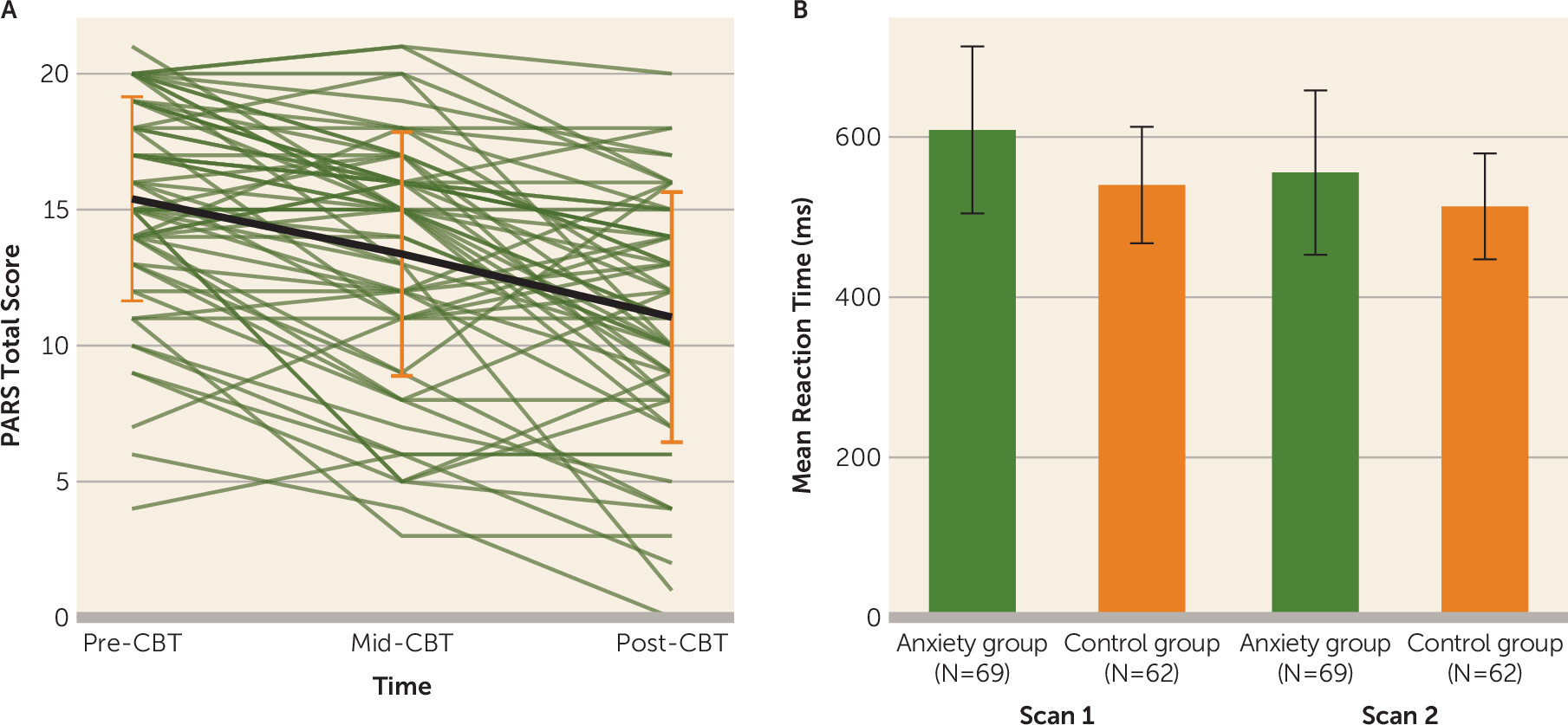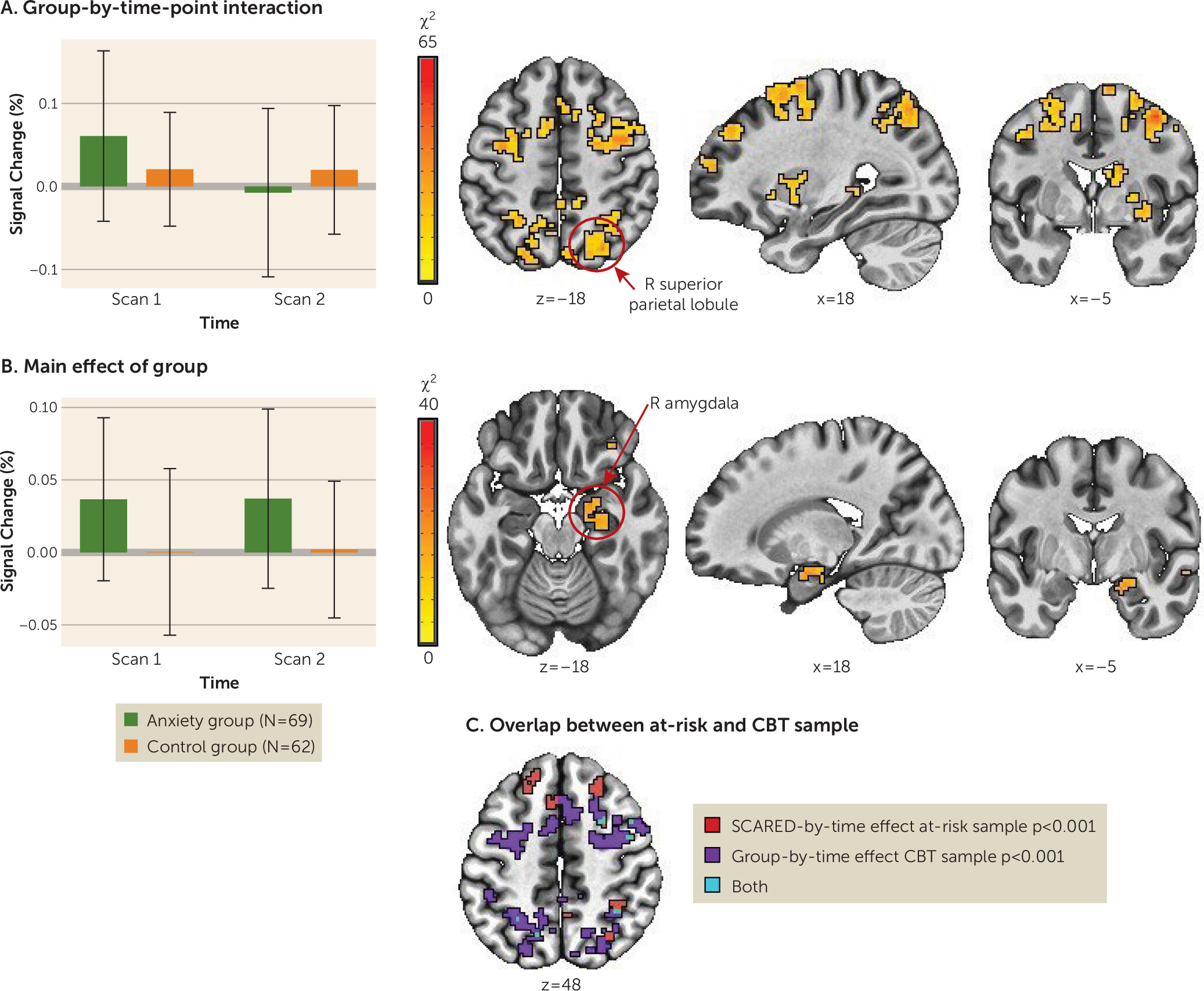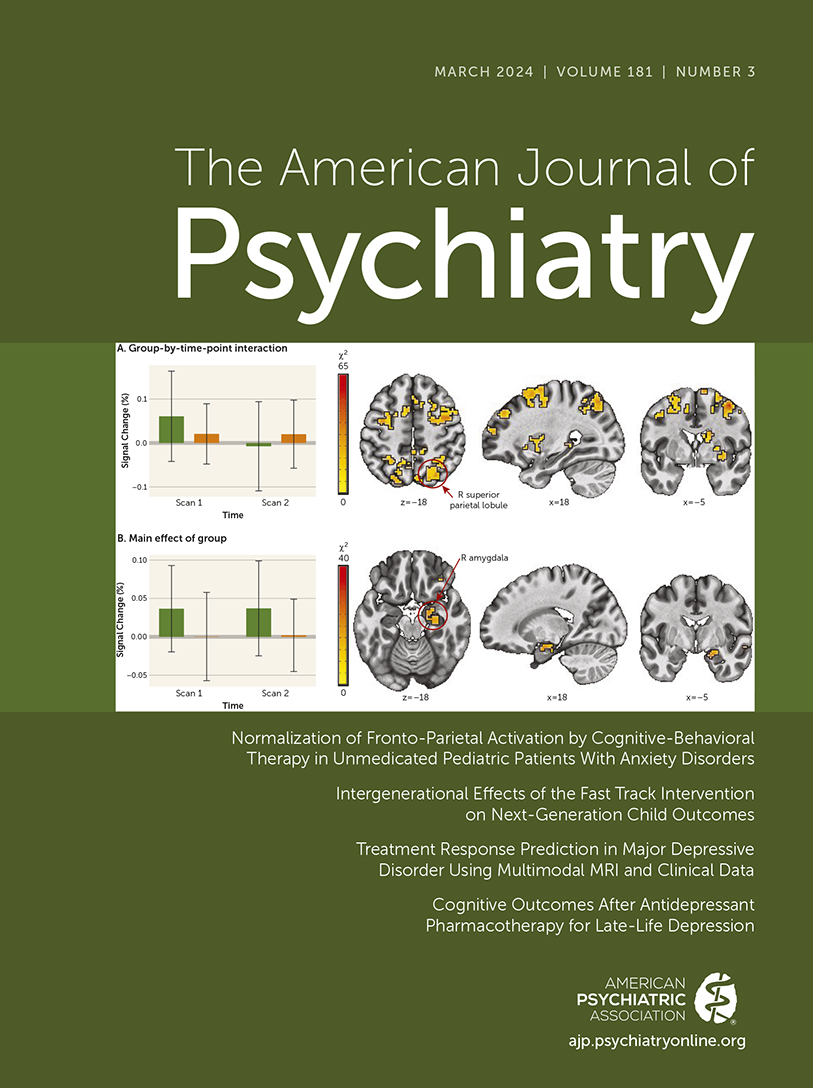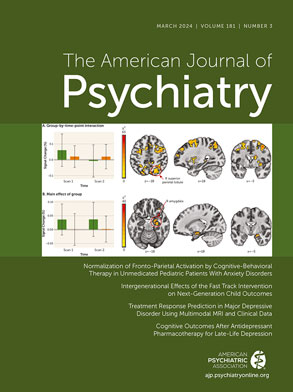Normalization of Fronto-Parietal Activation by Cognitive-Behavioral Therapy in Unmedicated Pediatric Patients With Anxiety Disorders
Abstract
Objective:
Methods:
Results:
Conclusions:
Methods
Participants
| Characteristic | Anxiety Group (N=69) | Control Group (N=62) | ||
|---|---|---|---|---|
| | Mean | SD | Mean | SD |
| Age (years) | 12.79 | 2.98 | 13.66 | 2.23 |
| IQ | 114.36 | 13.79 | 111.72 | 12.02 |
| | N | % | N | % |
| Maleb | 23 | 33.33 | 30 | 48.39 |
| Raceb | | | | |
| Asian | 1 | 2 | 3 | 5 |
| American Indian or Alaskan Native | 1 | 2 | 0 | 0 |
| Black or African American | 1 | 2 | 14 | 23 |
| Multiple races | 10 | 14 | 6 | 10 |
| Native Hawaiian or Other Pacific Islander | 1 | 2 | 0 | 0 |
| White | 50 | 73 | 19 | 31 |
| Unknown or undeclared | 5 | 8 | 19 | 31 |
| Ethnicity | | | | |
| Latino or Hispanic | 9 | 13 | 2 | 3 |
| Not Latino or Hispanic | 56 | 81 | 42 | 68 |
| Unknown or undeclared | 4 | 6 | 18 | 29 |
| Combined family income | | | | |
| <$25,000 | 5 | 7 | 3 | 5 |
| $25,000–$39,999 | 1 | 2 | 3 | 5 |
| $40,000–59,999 | 1 | 2 | 4 | 7 |
| $60,000–89,999 | 5 | 7 | 2 | 3 |
| $90,000–$179,999 | 26 | 38 | 18 | 29 |
| ≥$180,000 | 29 | 42 | 11 | 18 |
| Unknown or undeclared | 2 | 2 | 21 | 34 |
| | Mean | SD | | |
| Pretreatment PARS total score | 15.40 | 3.75 | | |
| Posttreatment CGI-I score | 3.12 | 0.88 | | |
| | N | % | | |
| Current anxiety diagnoses | | | | |
| Generalized anxiety | 55 | 78 | | |
| Social anxiety | 43 | 62 | | |
| Separation anxiety | 19 | 28 | | |
| Specific phobia | 20 | 30 | | |
| Panic disorder | 1 | 2 | | |
Treatment and Measures
Threat Attention Task
fMRI Data Acquisition and Preprocessing
Statistical Analysis
Results
Demographic Characteristics and Treatment Effects

Behavioral Effects
Whole-Brain Analyses
Pre- to posttreatment change.
| Region | k | mm3 | CM LR | CM PA | CM IS | Mean | SEM | Anxiety-Control Difference Value | t | p | | | | | | | | | |
|---|---|---|---|---|---|---|---|---|---|---|---|---|---|---|---|---|---|---|---|
| R precentral gyrus | 93 | 1453 | 40.9 | −20.8 | 55.6 | 17.39 | 0.30 | 0.06 | 4.73 | <0.001 | | | | | | | | | |
| L precentral gyrus | 88 | 1375 | −35.1 | −28 | 62.9 | 16.21 | 0.23 | 0.06 | 4.70 | <0.001 | | | | | | | | | |
| R parahippocampal gyrus/amygdala | 76 | 1188 | 23.3 | −11.6 | −18.8 | 16.92 | 0.28 | 0.04 | 6.44 | <0.001 | | | | | | | | | |
| R superior temporal gyrus | 40 | 625 | 56.1 | −9.3 | −10.8 | 18.20 | 0.47 | 0.06 | 4.93 | <0.001 | | | | | | | | | |
| L postcentral gyrus | 30 | 469 | −46 | −18.9 | 50 | 16.53 | 0.42 | 0.05 | 4.74 | <0.001 | | | | | | | | | |
| L middle frontal gyrus | 24 | 375 | −26.8 | 51.4 | 8.6 | 16.18 | 0.41 | 0.03 | 4.64 | <0.001 | | | | | | | | | |
| R inferior frontal gyrus | 22 | 344 | 35.9 | 32.6 | −13.4 | 17.47 | 0.57 | 0.04 | 5.08 | <0.001 | | | | | | | | | |
| R inferior frontal gyrus | 21 | 328 | 45.4 | 19.5 | 26 | 16.26 | 0.37 | 0.05 | 4.44 | <0.001 | | | | | | | | | |
| Region | k | mm3 | CM LR | CM PA | CM IS | Mean | SEM | Anxiety: Time 1–Time 2 | t | p | Control: Time 1–Time 2 | t | p | Anxiety>Control, Time 1 | t | p | Anxiety>Control, Time 2 | t | p |
| R lingual gyrus | 535 | 8359 | 3.6 | −77.8 | 10.2 | 21.42 | 0.30 | −0.03 | −4.07 | <0.001 | 0.04 | 4.95 | <0.001 | −0.02 | −0.98 | 0.76 | 0.06 | 2.53 | 0.06 |
| R middle frontal gyrus | 434 | 6781 | 33.3 | 2.2 | 53.5 | 22.07 | 0.40 | 0.04 | 8.50 | <0.001 | −0.01 | −2.24 | 0.11 | 0.03 | 3.91 | <0.001 | −0.02 | −2.26 | 0.11 |
| R superior parietal lobule | 264 | 4125 | 19.2 | −69.2 | 53.4 | 19.85 | 0.31 | 0.07 | 10.25 | <0.001 | 0.00 | 0.09 | 1.00 | 0.04 | 2.90 | 0.02 | −0.03 | −2.50 | 0.06 |
| R superior temporal gyrus | 256 | 4000 | 55.7 | −41.8 | 20.8 | 22.61 | 0.59 | 0.05 | 10.75 | <0.001 | 0.00 | −0.82 | 0.84 | 0.03 | 3.30 | 0.01 | −0.02 | −2.34 | 0.10 |
| R inferior temporal gyrus | 215 | 3359 | 43.7 | −64.4 | −7.9 | 19.08 | 0.31 | 0.06 | 11.09 | <0.001 | 0.00 | 0.40 | 0.98 | 0.03 | 2.06 | 0.17 | −0.04 | −2.96 | 0.02 |
| L precentral gyrus | 189 | 2953 | −31.5 | −1.4 | 53.9 | 18.96 | 0.35 | 0.04 | 8.76 | <0.001 | −0.01 | −1.26 | 0.59 | 0.02 | 1.88 | 0.24 | −0.03 | −3.49 | 0.00 |
| L inferior parietal lobule | 180 | 2813 | −21.7 | −55.2 | 47.7 | 21.35 | 0.53 | 0.03 | 9.19 | <0.001 | −0.01 | −2.03 | 0.18 | 0.01 | 1.30 | 0.56 | −0.03 | −4.31 | <0.001 |
| L middle occipital gyrus | 171 | 2672 | −46.4 | −70.3 | 2.2 | 19.87 | 0.33 | 0.06 | 10.57 | <0.001 | 0.01 | 1.43 | 0.48 | 0.03 | 2.12 | 0.15 | −0.03 | −1.79 | 0.28 |
| L supplementary motor area | 135 | 2109 | 1.3 | 10.6 | 46 | 18.93 | 0.40 | 0.03 | 5.44 | <0.001 | −0.02 | −3.46 | 0.00 | 0.03 | 2.55 | 0.06 | −0.03 | −2.60 | 0.05 |
| R putamen | 123 | 1922 | 31.1 | 8 | −0.7 | 19.37 | 0.38 | 0.02 | 4.51 | <0.001 | −0.19 | −4.64 | <0.001 | 0.02 | 3.46 | 0.00 | −0.02 | −2.56 | 0.06 |
| L middle occipital gyrus | 98 | 1531 | −28 | −72.2 | 29.1 | 20.71 | 0.62 | 0.04 | 8.30 | <0.001 | 0.00 | −0.11 | 1.00 | 0.01 | 1.01 | 0.74 | −0.03 | −2.48 | 0.07 |
| R caudate nucleus | 89 | 1391 | 15 | −5.1 | 17.5 | 20.84 | 0.55 | 0.02 | 2.78 | 0.03 | −0.04 | −5.71 | <0.001 | 0.05 | 4.69 | <0.001 | −0.01 | −1.11 | 0.68 |
| R middle frontal gyrus | 61 | 953 | 29.6 | 44.3 | 34.3 | 19.40 | 0.57 | 0.01 | 1.89 | 0.23 | −0.04 | −6.23 | <0.001 | 0.03 | 3.67 | 0.00 | −0.02 | −1.76 | 0.30 |
| L middle frontal gyrus | 57 | 891 | −35.8 | 48.8 | 2 | 19.29 | 0.65 | −0.03 | −4.94 | <0.001 | 0.02 | 3.28 | 0.01 | −0.01 | −0.97 | 0.77 | 0.04 | 4.82 | <0.001 |
| L middle cingulate cortex | 54 | 844 | −10.1 | 12.7 | 36.1 | 18.80 | 0.63 | 0.02 | 4.07 | <0.001 | −0.02 | −3.81 | <0.001 | 0.03 | 3.27 | 0.01 | −0.01 | −1.77 | 0.29 |
| R middle occipital gyrus | 53 | 828 | 34.1 | −68.7 | 36.5 | 18.75 | 0.49 | 0.04 | 7.94 | <0.001 | 0.00 | −0.11 | 1.00 | 0.03 | 3.36 | 0.01 | −0.01 | −1.43 | 0.48 |
| R precuneus | 53 | 828 | 6.8 | −44.1 | 53.3 | 19.33 | 0.75 | 0.01 | 2.39 | 0.08 | −0.04 | −5.66 | <0.001 | 0.04 | 3.52 | 0.00 | −0.01 | −0.59 | 0.93 |
| R inferior parietal lobule | 52 | 813 | 31.7 | −54.4 | 47.6 | 16.75 | 0.35 | 0.05 | 9.64 | <0.001 | 0.01 | 2.06 | 0.04 | 0.01 | 1.02 | 0.74 | −0.03 | −2.74 | 0.04 |
| R Rolandic operculum | 49 | 766 | 46.4 | −12.6 | 12.3 | 18.41 | 0.62 | −0.04 | −7.07 | <0.001 | 0.01 | 1.80 | 0.28 | −0.01 | −0.59 | 0.93 | 0.05 | 4.72 | <0.001 |
| L superior parietal lobule | 43 | 672 | −21 | −73 | 45.8 | 20.46 | 0.80 | 0.05 | 7.74 | <0.001 | 0.00 | −0.74 | 0.88 | 0.03 | 1.72 | 0.32 | −0.03 | −1.78 | 0.29 |
| L precuneus | 42 | 656 | −14.4 | −71.4 | 59.1 | 21.68 | 1.15 | 0.08 | 8.44 | <0.001 | −0.01 | −0.65 | 0.92 | 0.02 | 1.10 | 0.69 | −0.06 | −3.14 | 0.01 |
| R thalamus | 40 | 625 | 6.6 | −26.6 | 16.2 | 16.97 | 0.47 | 0.02 | 2.34 | 0.09 | −0.04 | −5.20 | <0.001 | 0.04 | 3.33 | 0.01 | −0.02 | −1.55 | 0.41 |
| R middle occipital gyrus | 40 | 625 | 36.7 | −77.9 | 18.7 | 19.24 | 0.70 | 0.05 | 8.35 | <0.001 | 0.00 | 0.49 | 0.96 | 0.02 | 1.58 | 0.40 | −0.03 | −1.79 | 0.28 |
| R superior frontal gyrus | 38 | 594 | 28.4 | 56.7 | 15.1 | 19.96 | 0.77 | 0.02 | 3.22 | 0.01 | −0.04 | −4.51 | <0.001 | 0.05 | 3.93 | <0.001 | −0.01 | −0.63 | 0.92 |
| L superior temporal gyrus | 37 | 578 | −59.2 | −45.7 | 19.4 | 19.55 | 0.59 | 0.04 | 7.71 | <0.001 | −0.01 | −2.22 | 0.12 | 0.03 | 3.85 | 0.00 | −0.01 | −1.44 | 0.48 |
| Cerebellar lobule VIIIa | 36 | 563 | −1 | −74.9 | −39.8 | 19.81 | 0.79 | 0.04 | 6.55 | <0.001 | −0.02 | −2.17 | 0.13 | 0.04 | 3.25 | 0.01 | −0.02 | −1.83 | 0.27 |
| L inferior occipital gyrus | 34 | 531 | −24 | −95.9 | −6.1 | 21.00 | 1.01 | 0.04 | 4.23 | 0.00 | −0.04 | −4.04 | <0.001 | 0.07 | 2.90 | 0.02 | −0.01 | −0.44 | 0.97 |
| Cerebellar vermis, 4/5 | 31 | 484 | 1.8 | −61.1 | −14.9 | 20.15 | 1.17 | 0.02 | 5.41 | <0.001 | −0.01 | −2.75 | 0.03 | 0.02 | 3.04 | 0.02 | −0.01 | −1.85 | 0.25 |
| R supplementary motor area | 30 | 469 | 11 | 0.4 | 72.4 | 21.00 | 1.11 | 0.06 | 8.20 | <0.001 | 0.00 | −0.41 | 0.98 | 0.04 | 2.76 | 0.03 | −0.02 | −1.31 | 0.56 |
| R superior temporal gyrus | 29 | 453 | 45.1 | −31 | 13.7 | 23.76 | 1.44 | −0.04 | −5.90 | <0.001 | 0.02 | 2.52 | 0.06 | 0.00 | −0.16 | 1.00 | 0.06 | 4.63 | <0.001 |
| R middle cingulate cortex | 29 | 453 | 6.6 | 24.1 | 30.8 | 16.46 | 0.42 | 0.02 | 2.95 | 0.02 | −0.03 | −3.83 | <0.001 | 0.03 | 2.80 | 0.30 | −0.02 | −1.72 | 0.32 |
| R postcentral gyrus | 29 | 453 | 46.4 | −34.9 | 59.8 | 19.21 | 0.77 | 0.07 | 6.66 | <0.001 | −0.01 | −1.17 | 0.65 | 0.06 | 2.77 | 0.03 | −0.02 | −0.99 | 0.76 |
| R hippocampus | 28 | 438 | 24.4 | −32.9 | 6.2 | 20.11 | 0.99 | 0.01 | 4.14 | <0.001 | −0.02 | −4.83 | <0.001 | 0.03 | 5.38 | <0.001 | 0.00 | −0.90 | 0.81 |
| R fusiform gyrus | 27 | 422 | 43.3 | −39.3 | −18.3 | 20.79 | 0.92 | 0.04 | 7.34 | <0.001 | −0.01 | −0.99 | 0.76 | 0.03 | 3.32 | 0.01 | −0.01 | −0.88 | 0.82 |
| L superior temporal gyrus | 26 | 406 | −41.6 | −37.4 | 19.3 | 19.09 | 0.83 | −0.03 | −3.93 | <0.001 | 0.02 | 3.57 | 0.00 | −0.01 | −1.04 | 0.73 | 0.04 | 3.28 | 0.01 |
| L lingual gyrus | 22 | 344 | −8.5 | −67.2 | −3 | 22.03 | 1.64 | −0.05 | −4.12 | <0.001 | 0.03 | 2.82 | 0.03 | −0.04 | −1.47 | 0.46 | 0.04 | 1.38 | 0.51 |
| Cerebellar vermis, 8 | 21 | 328 | −0.9 | −57.8 | −29.2 | 19.98 | 1.29 | −0.03 | −3.85 | <0.001 | 0.03 | 4.24 | <0.001 | −0.04 | −4.37 | <0.001 | 0.02 | 1.89 | 0.24 |

Associations between pretreatment activation patterns and treatment response.
Discussion
Baseline Differences in Fronto-Parietal Networks
Fronto-Parietal Networks and Treatment-Related Change
Pretreatment Activation Patterns and Treatment Response
Strengths and Limitations
Conclusions
Acknowledgments
Supplementary Material
- View/Download
- 1.52 MB
References
Information & Authors
Information
Published In
History
Keywords
Authors
Competing Interests
Funding Information
Metrics & Citations
Metrics
Citations
Export Citations
If you have the appropriate software installed, you can download article citation data to the citation manager of your choice. Simply select your manager software from the list below and click Download.
For more information or tips please see 'Downloading to a citation manager' in the Help menu.

